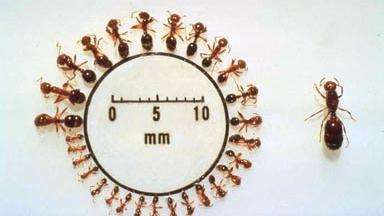Imported Fire Ants

Imported fire ants (Solenopsis invicta Buren and S. richteri Forel) are invasive pests that may feed on crops such as sorghum, corn, and small grain seeds, forage grass, and citrus seedlings. They can also girdle young trees and injure animals and people. Their large nests located in fields interfere with and damage equipment during cultivation and harvesting. They can move to non-infested areas by hitchhiking on agricultural commodities.
A single fire ant can sting repeatedly. Young and newborn animals are especially susceptible to the venomous sting. They also damage the environment, displace native ant species, and reduce wildlife food sources. First introduced to the United States from South America decades ago, imported fire ants likely arrived in soil on cargo ships. Today, they are found throughout the Southern United States and in parts of California and Puerto Rico.
Open, sunny areas like pastures, parks, lawns, meadows, and fields are most attractive to imported fire ants. Here's what to look for:
- Appearance
- Ants are 1/8- to 1/4-inch long and reddish-brown or black in color.
- Nests
- Hard, mound-shaped nests; may get quite large (up to 18-24 inches high) and pose a risk to field workers and farm equipment
- Small white fire ant eggs, larvae, and pupae may be visible on top of their mounds.
- Stings
- Ants respond rapidly and aggressively when disturbed; hundreds of fire ants may swarm and run up vertical surfaces to sting. Stings from imported fire ants are painful and cause a burning sensation and itching blisters.
If you are unsure of the ant species you see, contact your local extension office for their help to identify the species.
Imported fire ants move and spread naturally to non-infested areas and hitchhike on agricultural commodities. To help keep these pests from spreading to new areas, follow the regulations on moving baled hay, soil, plants, soil-moving equipment, and other items out of imported fire ant quarantine areas.
There are many fire ant treatment methods and products approved for use. Contact your local extension specialist for guidance on what will work best for your situation.
If you're a producer or homeowner looking for general guidance, we recommend this helpful resource from the University of Georgia extension office.
Report Plant Pests and Diseases
Have you seen this pest or signs of pest damage? Immediately report your findings.
Find your State plant regulatory official
Find your State plant health director
Controlling Imported Fire Ants
Imported fire ants infest more than 367 million acres in Alabama, Arkansas, California, Florida, Georgia, Louisiana, Mississippi, New Mexico, North Carolina, Oklahoma, South Carolina, Tennessee, Texas, Virginia, and Puerto Rico. APHIS has established quarantine areas where we know imported fire ant colonies exist. The quarantines prevent artificial (human-assisted) spread of imported fire ants. We work with State cooperators to regulate high-risk commodities, such as nursery stock, hay, and soil-moving equipment.
- Imported Fire Ant Quarantine Interactive Map
- Imported Fire Ant Quarantine Map (1.6 MB)
- List of Regulated Articles (135.58 KB)
- Select your State from the drop down menu below to see if it has a Federal quarantine for imported fire ants.
Pest Tracker: Find Pests by State or Region
Find out if your State has a Federal quarantine and/or State-level quarantine for any hungry pests.
APHIS works to manage imported fire ants in infested areas. We work with States, industry, and other Federal agencies to develop and evaluate regulatory treatments for high-risk commodities and revise regulations and procedures as needed.
Recent Federal Orders
- February 14, 2024, APHIS Expands Quarantine Area for the Imported Fire Ant (Solenopis invicta, S. richteri, and hybrids of these species) in Oklahoma and Tennessee (190.05 KB)
- July 25, 2023, APHIS Expands Quarantine Areas for the Imported Fire Ant (Solenopis invicta, S. richteri, and hybrids of these species) in Virginia. (137.72 KB)
- October 27, 2022, Expansion of Quarantine Areas for the Imported Fire Ant (Solenopis invicta Buren, S. richteri Forel, and hybrids of these species) in Arkansas and Tennessee
Contact your State plant health director or State plant regulatory official to request a certificate if you want to move a regulated article out of a quarantine area. The required document is issued by State or Federal personnel upon inspection of the regulated article to be moved.
- Regulated Areas
- Regulated Articles
- Imported Fire Ant: Quarantine Treatments for Nursery Stock, Grass Sod, and Related Materials
- Questions and Answers: Federal Imported Fire Ant Quarantine Information for Nursery/Sod Growers
- Questions and Answers: Moving Baled Hay From Areas Under Quarantine for Imported Fire Ant (916.5 KB)

